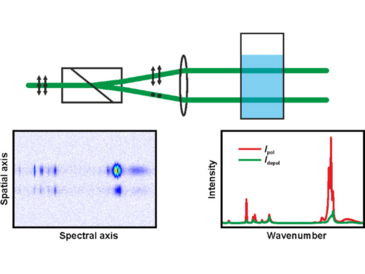Johannes Kiefer.
Analytical Chemistry (2017) 89 (11), 5725-5728
http://dx.doi.org/10.1021/acs.analchem.7b01106
Polarization-resolved Raman spectroscopy provides much more information than its conventional counterpart. However, it usually either requires a complicated setup with two spectrographs and detectors or two measurements must be performed sequentially. This study presents a simple and straightforward approach to recording both polarization components simultaneously with a single spectrograph and detector. The vertically and a horizontally polarized laser beam exiting a Wollaston prism are focused into the sample with a small spatial separation. The scattered light from both beams is imaged onto the slit of an imaging spectrograph as two spatially separated signals, i.e., the polarized and the depolarized Raman signal. Eventually, both spectra are acquired on a single CCD chip simultaneously. Experimental data of ethanol and dimethyl sulfoxide are shown as proof-of-concept. The new method has a number of advantages, for example, laser intensity fluctuations and the polarization dependence of the diffraction grating do not play a role. The proposed approach will be useful for an improved structural analysis and it will be the enabling technology for temporally resolved enantioselective Raman (esR) spectroscopy.


